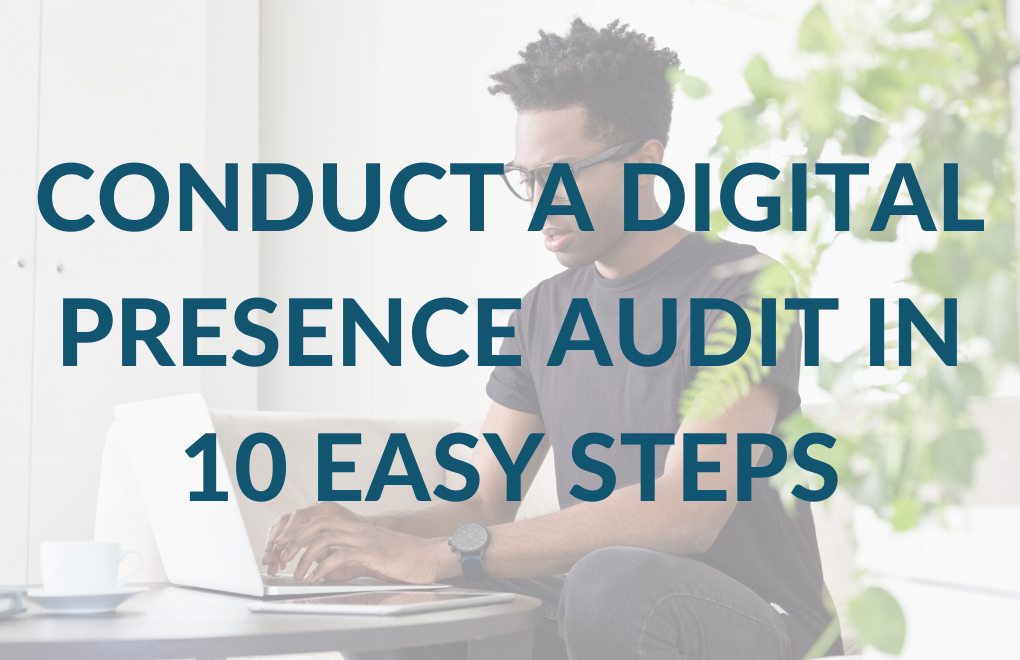Audit your company’s digital presence by following this 10-step plan.
How to conduct a digital presence audit for your business?
In the previous parts of this Digital Presence Audit series, we’ve taken a look at clarifying your website and building a strong social media presence, and I’ve also shared my insights on how these elements can be easily improved.
Throughout the series, I’ve received questions on how to conduct a complete Digital Presence Audit for your company. Many fear that the process is long and complicated and cannot be executed without an army of consultants.
To simplify the process, I condensed my audit framework into 10 essential steps to go through on your own or with your team.
Here you go!
1 – List All the Platforms
The goal of a Digital Presence audit is to ensure that all your channels deliver a consistent message about your brand to your audience. That’s why we start by listing in one document all the channels you use to promote your business.
These might include:
- Website
- Campaign-specific landing pages
- Newsletter opt-in pages and forms
- Social media channels
- Chatbots and customer service channels (Facebook Messenger, WhatsApp, Olark…)
- Google My Business and other similar platforms
- Map applications
- Market places and apps (Uber, AppStore, Fiverr, Booking.com…)
- Review sites (TripAdvisor, Yelp…)
- Content platforms (Medium…)
I recommend using a spreadsheet to keep track of all the channels. List all the platforms in the first column and create a column for each of the questions that follow. Then add a plus or minus sign or a simple Y or N to indicate the parts that still need work.
Doing it once makes all the future audits quick and painless, too.
2 – Align Branding across Platforms
Next, check that the key elements of your brand are identical across all the platforms. Check at least the following things:
- Do you have the same profile photo on all platforms? Use your logo whenever possible.
- Is your name spelled correctly and the same way everywhere? Stay loyal to the capital / small letters whenever you can but don’t stress about it if some platforms force you to make an exception.
- Are the contact details correct and up-to-date?
3 – Standardise Brand Introduction
After checking visual elements and branding, focus on the brand or company introduction.
Different platforms allow for different lengths in the introduction. So, you will need several versions from 150 characters on an Instagram bio to 2000 characters on LinkedIn’s About Us section.
On your website, this core message should come across before a visitor needs to scroll for more than 2-3 seconds.
The important part is that regardless of the character limit, the story stays consistent and it has a strong focus on the value you deliver to your customers.
4 – Make Sure All the Channels Sound the Same
Now, all your channels are saying the same thing but are they saying it in the same way?
In communications slang, we often speak about a brand’s “tone of voice”. Practically speaking, you can think about it as the way you address your clients.
All channels should use more or less similar vocabulary and have a similar approach to the audience. There can be some differences from one platform to another, if they address different audience or client segments. Just make sure these differences are intentional and support your communication goals.
5 – Speak More About Your Clients than Yourself
Let’s focus on your content next.
Your website and social media are about you and your business. But to make an impact and engage with your audience in a meaningful way, you need to make your content about them.
Check your content to see if you’re using sentences with “I” or “We” more than ones with “You” to put your customer in focus. Focus on the value your clients will perceive, on how they feel now and will feel after working with you or buying your service or product.
6 – Check Publication Frequency
While we’re on the topic of content, review your publication frequency to make sure it’s consistent.
Consistency and frequency mean different things on different platforms. A website rarely needs to be updated more often than every 6-18 months. On social media, a weekly presence is almost a must.
On third-party platforms, such as review sites and marketplaces, instead of frequency, focus on keeping your information up-to-date and answering questions and feedback regularly. Even – and especially – bad reviews.
7 – Create Recognisable Content
One more check about content: Do all the content across platforms look and feel the same?
Look over your topics and see if they are aligned and if your visuals are recognisable. You can, for example, pick 5 social media posts, 1 subpage on your website etc. and ask yourself: If a loyal follower saw this out of context, would they recognize that it’s ours?
The answer should be yes at least four times out of five.
8 – Update Linking Strategy
Next we’ll move on to what you want your website’s or social media’s visitors to do next.
Make sure your calls-to-action are aligned with where you want people to go. Clarify and simplify them to create a frictionless experience.
9 – Check Links
Once you’re happy with the calls-to-action and where they are supposed to take your clients, check that the links work. This sounds obvious but even one broken link can hurt your conversion and client experience.
On your own website, you can build up a personalised error page where visitors will be guided in case of broken links. The page can guide visitors to your Service page or Blog, for example, to keep them on the site in case your linking fails.
10 – Prioritise Projects that Need Fixing
Congratulations, you’ve completed your Digital Presence Audit! Now, look at your spreadsheet and Y/N and +/- signs to get an overview of the situation.
Next question arises: where do you start? Aim to fix one problem at a time by starting with the most important ones.
It’s also a good idea to schedule the next audit in your communication team’s calendar in 3-6 months time. When you get into the rhythm, a check-in every 6-12 months will probably be enough.
If you need additional help in conducting your own Digital Presence Audit, you can schedule your 1:1 Power Hour. In this 1:1 Digital Audit I’ll help you sharpen your message and align your digital channels to contribute to your business success.







Trackbacks/Pingbacks